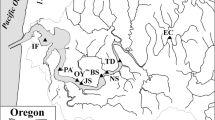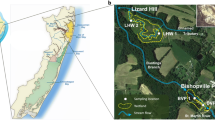Abstract
Denitrification measurements were made under simulated field conditions using sediment cores and water collected from the Hemet/San Jacinto Multipurpose Demonstration Wetland (Riverside Country, California, USA). The 9.9 ha constructed wetland is used to both polish ammonia-dominated secondary municipal effluent and provide migratory bird habitat. The wetland was originally constructed as a marshpond-marsh system in 1994. Over the period from January through March 1998, measured denitrification rates averaged 20.9±20.9 μmol N m−2 h−1 within the emergent marsh portions of the wetland and 646±353 μmol N m−2 h−1 in open water areas. The mean areal denitrification removal rate for this period was 0.70 kg N ha−1 d−1, which accounted for about 8% of the total N removed by the wetland. Internal retention was the main N-removal mechanism. Synoptic water quality surveys indicated that denitrification was limited by a lack of nitrification within the wetland. Between April 1998 and January 1999, the wetland was reconfigured as a hemi-marsh system, having equal areas of interspersed emergent marsh and deep open water. In May 1999, measured denitrification rates averaged 1414±298 μmol N m−2 h−1 within the emergent marsh zones and 682±218 μmol N m−2 h−1 in the open water areas. The mean areal denitrification removal rate was 3.58 kg N ha−1 d−1, which accounted for 40% of the total N removed by the wetland. A synoptic water quality survey indicated that nitrification within the wetland had been enhanced by the reduction of emergent macrophyte biomass and the increase in the area of interspersed deep open water. The modifications to the wetland shifted the nitrogen balance from a large internal storage component and a small denitrification component in 1998 to a more denitrifying system in 1999.
Similar content being viewed by others
Literature Cited
Bowden, W. B. 1986. Nitrification, nitrate reduction, and nitrogen immobilization in a tidal freshwater marsh sediment. Ecology 67: 88–99.
Bowden, W. B. 1988. The biogeochemistry of nitrogen in freshwater wetlands. Biogeochemistry 4:313–348.
Caffrey, J. M. and W. M. Kemp. 1992. Influence of the submersed plant, Potamogeton perfolaitus, on nitrogen cycling in estuarine sediment. Limnology and Oceanography 37:1483–1495.
Cole, S. 1998. The emergence of treatment wetlands. Environment Science and Technology 32:218–223.
Colt, J. 1984. Computation of dissolved gas concentrations in water as functions of temperature, salinity, and pressure. American Fisheries Society Special Publication Number 14.
DeBusk, W. F. and K. R. Reddy. 1987. Removal of floodwater nitrogen in a cypress swamp receiving primary wastewater effluent. Hydrobiologia 153:79–86.
Denmead, O. T., J. R. Freney, and J. R. Simpson. 1982. Dynamics of ammonia volatilization during furrow irrigation of maize. Soil Science of America Journal 46:149–155.
Dierberg, F. E. and P. L. Brezonik. 1984. Nitrogen and phosphorus mass balances in a cypress dome receiving wastewater. p. 112–118. In K. C. Ewel and H. T. Odum (eds.) Cypress Swamps. University of Florida Press, Gainesville, FL, USA.
Fetter, C. W., Jr., W. E. Sloey, and F. L. Spangler. 1978. Use of a natural marsh for wastewater polishing. Journal of the Water Pollution Control Federation 50:290–307.
Frankenbach, R. I. and J. S. Meyer. 1999. Nitrogen removal in a surface-flow wastewater treatment wetland. Wetlands 19:403–412
Freney, J. R., R. Leuning, J. R. Simpson, O. T. Denmead, and W. A. Muirhead. 1985. Estimating ammonia volatilization from flooded rice fields by simplified techniques. Soil Science Society of America Journal 49:1049–1054.
Gearheart, R. a. 1992. Use of constructed wetlands to treat domestic wastewater, City of Arcata, California. Water Science and Technology 26:1625–1637.
Gersberg, R. M., B. V. Elkins, S. R. Lyon, and C. R. Goldman. 1986. Role of aquatic plants in wastewater treatment by artificial wetlands. Water Research 20:363–368.
Grant, R. R. and R. Patrick. 1970. Tinicum Marsh as a water purifier. p. 105–131. In J. McCormick, R. R. Grant, Jr., and R. Patrick (eds.) Two Studies of Tinicum Marsh, Delware and Philadelphia Counties, Pa. The Conservation Foundation, Washington, DC, USA.
Hayes, J. P. and J. W. Caslick. 1984. Nutrient deposition in cattail stands by communally roosting blackbirds and starlings. American Midland Naturalist 112:320–331.
Hemond, H. F. and J. Benoit. 1988. Cumulative impacts on water quality functions of wetlands. Environmental Management 12:639–653.
Johnston, C. A. 1991. Sediment nutrient retention by freshwater wetlands: Effects on surface water quality. CRC Reviews Environmental Control 21:491–565.
Kadlec, R. H. 1993. The Bellaire wetland: wastewater alteration and recovery. Wetlands 3:44–63.
Kadlec, R. H. 1994. Wetlands for water polishing: free water surface wetlands. p. 335–349. In W. J. Mitsch (ed.) Global Wetlands Old World and New. Elsevier Science B.V. Amsterdam, Netherlands.
Kana, T. M., C. Darkangelo, M. D. Hunt, J. B. Oldham, G. E. Bennett, and J. C. Cornwell. 1994. Membrane inlet mass spectrometer for rapid high precision determination of N2, O2, and Ar in environmental water samples. Analytical Chemistry 66:4166–4170.
Kana, T. M., M. B. Sullivan, J. C. Cornwell, and K. Groszowski. 1998. Denitrification in estuarine sediments determined by membrane inlet mass spectrometry. Limnology and Oceanography 43:334–339.
Knight, R. L. and K. A. Ferda. 1989. Performance of the Boggy Gut wetland treatment system, Hilton Head, South Carolina. p. 439–450. In D. E. Fisk (ed.) Water: Laws and Management. American Water Resources Association, Bethesda, MD, USA.
Knight, R. L., T. W. McKim, and H. R. Kohl. 1987. Performance of a natural wetland treatment system for wastewater management. Journal of the Water Pollution Control Federation 59:746–754.
Knight, R. L. and B. H. Winchester. 1985. Ecology, hydrology, and advanced wastewater treatment potential of an artificial wetland in North-Central Florida. Wetlands 5:167–180.
Knowles, R. 1982. Denitrification. Microbiological Reviews 46:43–70.
Manny, B. A., W. C. Johnson, and R. G. Wetzel. 1994. Nutrient additions by waterfowl to lakes and reservoirs: predicting their effects on productivity and water quality. Hydrobiologia 279/280: 121–132.
Mitsch, W. J. and J. G. Gosselink. 1993. Wetlands. Van Nostrand Reinhold, New York, NY, USA.
Nixon, S. W. and V. Lee. 1986. Wetlands and water quality. Final Report. Department of the Army, Vicksburg, MS, USA. Technical Report Y-86-2.
Patruno, J. and J. Russell. 1994. Natural wetland polishing effluent discharging to Wooloweyah Lagoon. Water Science and Technology 29:185–192.
Pinney, M. L., P. K. Westerhoff, and L. Baker. 2000. Transformations in dissolved organic carbon through constructed wetlands. Water Research 34:1897–1911.
Prior, B. 2000. Sweetwater Wetlands mosquito control update. Mosquito Connection 5(March 2000):4–5.
Reddy, K. R., W. H. Patrick, Jr., and C. W. Lindau. 1989. Nitrification-denitrification at the plant root-sediment interface in wetlands. Limnology and Oceanography 34:1004–1013.
Reed, S. C., E. J. Middlebrooks, and R. W. Crites. 1988. Natural Systems for Waste Water Management. McGraw-Hill, New York, NY, USA.
Sartoris, J. J. and J. S. Thullen. 1998. Developing a habitat-driven approach to CWWT design. p. 716–721. In Proceedings of Engineering Approaches to Ecosystem Restoration. American Society of Civil Engineers, Denver, CO, USA.
Sartoris, J. J., J. S. Thullen, L. B. Barber, and D. E. Salas. 2000. Investigation of nitrogen transformations in a southern California constructed wastewater treatment wetland. Ecological Engineering 14:49–65.
Seitzinger, S. P., L. P. Nielsen, J. Caffrey, and P. B. Christensen. 1993. Denitrification measurements in aquatic sediments: a comparison of three methods. Biogeochemistry 23:147–167.
Seitzinger, S. P. 1994. Linkages between organic matter mineralization and denitrification in eight riparian wetlands. Biogeochemistry 25:19–39.
Smith, S. G. 1995. New combinations in North American Schoenoplectus, Bolboschoenus, Isolepis, and Trichophorum (Cyperaceae). Novon 5:97–102.
Stiles, E. A. 1994. An integrated design approach for multipurpose constructed wetlands. p. 723–731. In Proceedings of the Fourth International Conference on Wetland Systems for Water Pollution Control. South China Institute for Environmental Studies. Guangzhou, China.
U. S. Bureau of Reclamation. 1993. Design Concepts and Criteria Report, Multipurpose constructed wetlands, Hemet site demonstration project, USBR, Denver, CO, USA.
U. S. Environmental Protection Agency. 1984. Methods for chemical analysis of water and wastes. National Technical Information Service PB84-128677.
U. S. Environmental Protection Agency. 1988. Design Manual — Constructed Wetlands and Aquatic Plant Systems for Municipal Water Treatment. USEPA, Cincinnati, OH, USA. EPA/625/1-88/022.
Weller, M. W. and C. S. Spatcher. 1965. Role of habitat in the distribution and abundance of marsh birds. Agricultural and Home Economics Experiment Station, Iowa State University, Ames, IA, USA. Special Report No. 43.
Whigham, D. F., C. Chittlering, and B. Palmer. 1988. Impacts of freshwater wetlands on water quality: A landscape perspective. Environmental Management 12:663–671.
Xue, Y., D. A. Kovacic, M. B. David, L. E. Gentry, R. L. Mulvaney, and C. W. Lindau. 1999. In situ measurements of denitrification in constructed wetlands. Journal of Environmental Quality 28:263–269.
Yoh, M., A. Yagi, and H. Terai. 1990. Significance of low-oxygen zone for nitrogen cycling in a freshwater lake: production of N2O by simultaneous denitrification and nitrification. Japanese Journal of Limnology 51:163–171.
Author information
Authors and Affiliations
Corresponding author
Rights and permissions
About this article
Cite this article
Smith, L.K., Sartoris, J.J., Thullen, J.S. et al. Investigation of denitrification rates in an ammonia-dominated constructed wastewater-treatment wetland. Wetlands 20, 684–696 (2000). https://doi.org/10.1672/0277-5212(2000)020[0684:IODRIA]2.0.CO;2
Received:
Revised:
Accepted:
Issue Date:
DOI: https://doi.org/10.1672/0277-5212(2000)020[0684:IODRIA]2.0.CO;2




